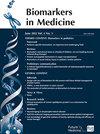与败血症相关的尿胱抑素 C 和尿 NGAL 可预测早产新生儿住院时间的延长。
IF 1.9
4区 医学
Q3 MEDICINE, RESEARCH & EXPERIMENTAL
引用次数: 0
摘要
目的:评估与早产新生儿(NBs)败血症有关的尿液生物标志物,并研究这些生物标志物对延长住院时间的预测能力:方法:采集27名健康新生儿、24名未患败血症的新生儿感染患者和11名患败血症的新生儿的血清和尿液,测量信迪康-1、与尿中性粒细胞明胶酶相关的脂钙蛋白(uNGAL)、尿胱抑素-C(uCysC)和尿肾损伤分子-1:结论:uNGAL与早产新生儿败血症有关,可用于预测住院时间的延长。本文章由计算机程序翻译,如有差异,请以英文原文为准。
Urinary cystatin-C and urinary NGAL associated with sepsis predicts longer hospital stay in premature newborns.
Aim: To evaluate the urinary biomarkers related to sepsis in preterm newborns (NBs) and to investigate the predictive capacity of these biomarkers for a longer hospital stay.Methods: Serum and urine were collected from 27 healthy NBs, 24 NBs with neonatal infection without sepsis and 11 NBs with sepsis for the measurement of sindecan-1, lipocalin associated with urinary neutrophil gelatinase (uNGAL), urinary cystatin-C (uCysC) and urinary kidney injury molecule-1.Results: Levels of uNGAL and urinary cystatin-C were elevated in NBs with sepsis and neonatal infection, and uNGAL was significant predictor of hospital stay longer than 30 days (odds ratio: 1.052; 95% CI: 1.012-1.093; p = 0.01).Conclusion: uNGAL was associated with sepsis in preterm NBs and was useful to predict extended hospital stay.
求助全文
通过发布文献求助,成功后即可免费获取论文全文。
去求助
来源期刊

Biomarkers in medicine
医学-医学:研究与实验
CiteScore
3.80
自引率
4.50%
发文量
86
审稿时长
6-12 weeks
期刊介绍:
Biomarkers are physical, functional or biochemical indicators of physiological or disease processes. These key indicators can provide vital information in determining disease prognosis, in predicting of response to therapies, adverse events and drug interactions, and in establishing baseline risk. The explosion of interest in biomarker research is driving the development of new predictive, diagnostic and prognostic products in modern medical practice, and biomarkers are also playing an increasingly important role in the discovery and development of new drugs. For the full utility of biomarkers to be realized, we require greater understanding of disease mechanisms, and the interplay between disease mechanisms, therapeutic interventions and the proposed biomarkers. However, in attempting to evaluate the pros and cons of biomarkers systematically, we are moving into new, challenging territory.
Biomarkers in Medicine (ISSN 1752-0363) is a peer-reviewed, rapid publication journal delivering commentary and analysis on the advances in our understanding of biomarkers and their potential and actual applications in medicine. The journal facilitates translation of our research knowledge into the clinic to increase the effectiveness of medical practice.
As the scientific rationale and regulatory acceptance for biomarkers in medicine and in drug development become more fully established, Biomarkers in Medicine provides the platform for all players in this increasingly vital area to communicate and debate all issues relating to the potential utility and applications.
Each issue includes a diversity of content to provide rounded coverage for the research professional. Articles include Guest Editorials, Interviews, Reviews, Research Articles, Perspectives, Priority Paper Evaluations, Special Reports, Case Reports, Conference Reports and Company Profiles. Review coverage is divided into themed sections according to area of therapeutic utility with some issues including themed sections on an area of topical interest.
Biomarkers in Medicine provides a platform for commentary and debate for all professionals with an interest in the identification of biomarkers, elucidation of their role and formalization and approval of their application in modern medicine. The audience for Biomarkers in Medicine includes academic and industrial researchers, clinicians, pathologists, clinical chemists and regulatory professionals.
 求助内容:
求助内容: 应助结果提醒方式:
应助结果提醒方式:


